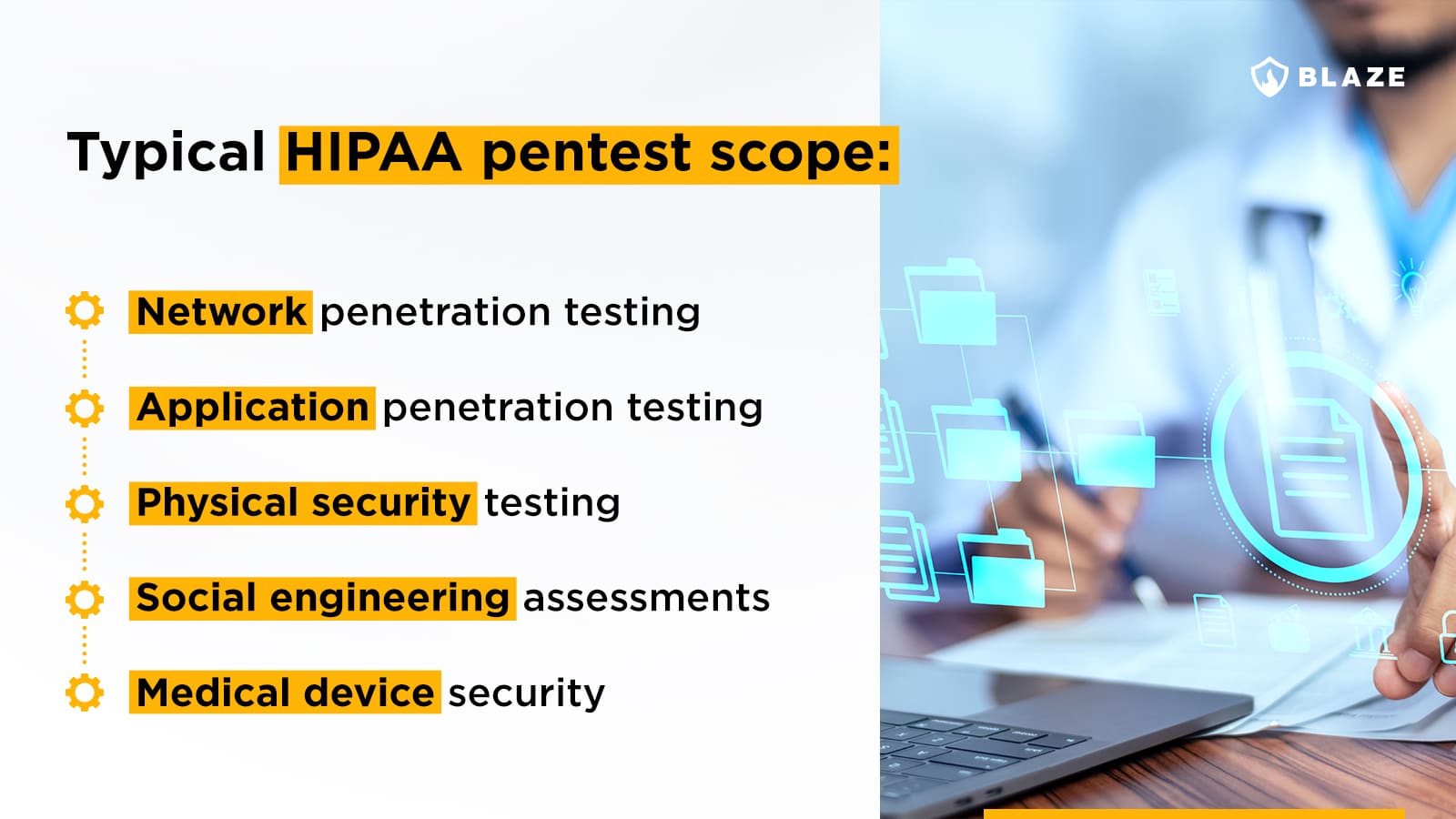In healthcare, safeguarding patient data is not just a regulatory requirement but a cornerstone of trust and operational reliability. Recent statistics from the HHS Office for Civil Rights (OCR) show a significant rise in healthcare data breaches and cybersecurity incidents. Between 2018 and 2022, large data breaches reported to OCR increased by 93% (from 369 to 712), with a 278% surge in ransomware-related breaches.
The Health Insurance Portability and Accountability Act (HIPAA) sets rigorous standards to safeguard sensitive patient information in the United States. As cyber threats evolve, simply adhering to standard compliance protocols is no longer sufficient. This is where vulnerability assessments and HIPAA penetration testing become indispensable tools for healthcare organizations. These practices are not simply about tick-box compliance; they are proactive measures to ensure the security and confidentiality of patient data in an all-digital healthcare industry.
This guide aims to demystify penetration testing assessments for professionals in the healthcare space. We will delve into what it entails, why it is important to augment HIPAA compliance, and how it forms an integral part of a robust healthcare cybersecurity strategy. Whether you’re a healthcare provider, a compliance officer, an IT professional in the field, or just keen on understanding the intricacies of securing patient data, this guide will provide insights and practical knowledge on HIPAA and cybersecurity.
Does HIPAA require penetration testing?
HIPAA does not explicitly require penetration testing, but a pentest is highly recommended as a measure to protect patient data. However, pentesting can support meeting numerous requirements set out by HIPAA and aligns with the NIST recommendation in achieving compliance with this regulation.
When writing this article, we thought it would be very important to answer this question about HIPAA penetration testing requirements immediately and address any topics about HIPAA compliance involving technical security assessments. But just because HIPAA doesn’t require pentesting explicitly, it doesn’t mean you should stop reading here.
HIPAA’s Evaluation section (§ 164.308(a)(8)) and Information Access Management (§ 164.308(a)(4)) highlight the need for regular technical and non-technical evaluations to assess the effectiveness of security controls for protecting electronic protected health information (ePHI). NIST Special Publication 800-66r2, involving HIPAA guidance, recommends external or internal penetration testing as a key method for these evaluations, supporting the HIPAA Security Rule standard in the following areas, extracted directly from the act’s General Rules:
- Ensure the confidentiality, integrity, and availability of all e-PHI they create, receive, maintain or transmit;
- Identify and protect against reasonably anticipated threats to the security or integrity of the information;
- Protect against reasonably anticipated, impermissible uses or disclosures
Undoubtedly, technical security evaluations, such as pen testing and vulnerability scanning, are effective at helping organizations demonstrate adherence to HIPAA compliance requirements for risk management and safeguarding ePHI against cyber threats.
What is HIPAA penetration testing?
HIPAA penetration testing is a specialized form of cybersecurity assessment specifically tailored for the healthcare industry to ensure compliance with the Health Insurance Portability and Accountability Act. This process involves simulating cyberattacks on an organization’s digital infrastructure to gain access to ePHI and identify vulnerabilities that malicious entities could potentially exploit.
Understanding the basics
Penetration testing, sometimes known as ethical hacking, is a proactive approach to cybersecurity. A penetration test actively seeks weaknesses in an organization’s network, applications, medical devices, etc. It does this by testing security controls and emulating real-world attackers’ tactics, techniques, and procedures, giving a healthcare organization a realistic understanding of its cybersecurity posture.
Tailoring pentesting to HIPAA requirements
What sets a HIPAA penetration test apart is its focus on the unique requirements of the healthcare sector. HIPAA mandates the protection of patient health information (PHI), requiring that healthcare providers and their business associates implement appropriate administrative, physical, and technical safeguards. Penetration testing for HIPAA compliance specifically targets these safeguards, ensuring they are robust enough to protect sensitive patient data from unauthorized access and breaches.
Common areas of scope of HIPAA pentesting
The scope of a HIPAA penetration testing exercise can vary, but it focuses on finding risks to ePHI and generally involves:

Regarding medical device cybersecurity, the FDA issued a guidance on September 2023 to address the topic, and it includes all details needed for medical device manufacturers to align with industry-accepted standards for Premarket Notification 510(k) and Postmarket Submissions.
The role of pentesting in healthcare cybersecurity
Penetration testing is key in determining potential weaknesses and security vulnerabilities that could jeopardize healthcare records and put the organization at risk of cyber attacks. Its importance stems from the HIPAA Security Rule’s requirements for risk assessment and management, which are critical for safeguarding electronic protected health information (ePHI).
In this section, we will dive into the main benefits that security assessments bring to the healthcare industry.
Addressing the threat landscape
- Evolving cyber threats: The threat landscape constantly changes, with new risks emerging regularly. Currently, the main cyber threat to healthcare providers is, by far, ransomware gangs. Penetration testing and vulnerability scans are proactive measures that help healthcare organizations anticipate these threats.
- Real-world attack simulation: By simulating real-world attack scenarios, penetration testing provides a practical assessment of how well an organization’s cybersecurity efforts and measures can withstand an actual cyberattack.
Comprehensive risk management
- Security beyond the surface: Vulnerability discovery and pentesting delve deeper than standard security measures, examining the effectiveness of an organization’s security policies, procedures, and controls.
- Identifying and prioritizing actual vulnerabilities: It helps pinpoint specific weaknesses based on the risk level, allowing for more targeted and effective remediation efforts.
Ensuring regulatory compliance
- Meeting HIPAA Security Rule requirements: The Security Rule requires covered entities to protect ePHI by implementing necessary safeguards. Penetration testing helps in evaluating whether these safeguards are adequate and effective.
- Documentation and evidence of compliance: The detailed reports generated from penetration tests can indicate an organization’s commitment to becoming HIPAA compliant.
Building patient trust
- Protecting patient data: By rigorously testing and improving their security posture, healthcare organizations can better protect patient data, a critical aspect of patient care and trust.
- Enhancing reputation: Demonstrating a proactive approach to data security can also enhance an organization’s reputation, showing a commitment to patient privacy and regulatory compliance.
Preparation for a HIPAA pentest
Effective preparation is key to ensuring HIPAA pentest’s success and legal compliance. Many items discussed in this section can also be useful for any security testing program. Before engaging, healthcare providers and their chosen cybersecurity partners must establish foundational agreements. Here’s a step-by-step guide on how to prepare:
Establish legal agreements
- Non-Disclosure Agreement (NDA): It goes without saying – initiate by signing an NDA with the pentest provider. This ensures that any sensitive information shared during the engagement remains confidential.
- Business Associate Agreement (BAA): Under HIPAA, a BAA is required when a business associate (in this case, the penetration testing provider) handles ePHI. This agreement sets forth the responsibilities of each party in protecting patient data. We have written a detailed article on BAA and healthcare pentesting, if you want to learn more.
Definition of objectives and scope
- Setting goals: Clearly define what the penetration test should accomplish, such as uncovering vulnerabilities or assessing compliance with specific HIPAA standards.
- Scoping the assessment: Determine the extent of the testing, focusing on systems, networks, and applications that interact with ePHI.
Selecting the penetration testing team
- Choosing experts: Decide between using an in-house team or third-party penetration testing experts. External teams often bring specialized skills and an unbiased perspective.
- Ensuring expertise: The chosen team should have proven experience in penetration testing, understanding the nuances of healthcare technology and protocols, and knowledge about the core aspects of HIPAA compliance.
Coordinating with internal stakeholders
- Informing and aligning teams: Communicate with relevant internal departments about the upcoming pentest. It’s crucial to ensure understanding and cooperation across the organization.
- Clarifying expectations: Discuss the pentest’s purpose, scope, and potential impacts to align expectations and avoid disruptions.
Technical and administrative readiness
- Backing up data: Securely backup all critical data, including ePHI, to prevent potential data loss during testing.
- Compliance and legal considerations: Confirm that the testing activities comply with legal and organizational policies.
Scheduling the test
- Minimizing operational impact: Schedule the assessment to cause minimal interference with everyday operations, considering possible system performance issues.
- Ongoing testing strategy: Plan regular penetration testing and vulnerability scanning to continuously monitor and improve cybersecurity and remain compliant.
Understanding the penetration testing process
The penetration testing process in a healthcare context is critical to ensure the security of sensitive patient data and compliance with HIPAA. Each phase of the pentesting process contributes to a thorough evaluation of a covered entity’s security posture. By identifying and addressing vulnerabilities in their systems, covered entities can have more confidence in their security controls regarding safeguarding patient data.
In this section, we discuss a high-level breakdown of the pentest process.
Planning phase
The process begins with careful planning. Here, specific elements of the healthcare organization’s IT infrastructure are identified for testing. This stage involves determining the scope of the test, which may include key systems like patient databases, healthcare apps, and other critical digital tools. It’s about setting clear objectives for the test and ensuring all relevant areas are covered.
Discovery phase
During the discovery phase, testers gather detailed information about the targeted environment. This involves understanding the network layout, software versions, and any known security measures. The goal is to map out the digital landscape of the healthcare organization, identifying potential weak points that could be exploited.
Attack and penetration phase
The attack phase is where simulated cyberattacks are conducted. Testers attempt to exploit identified vulnerabilities, mimicking the actions of potential hackers. This phase is crucial for assessing the real-world resilience of the organization’s security measures against unauthorized access or data breaches related to ePHI.
Reporting phase
The process concludes with a comprehensive and technically detailed report. The security testers compile their findings into a comprehensive document, highlighting discovered vulnerabilities, the potential risks associated with these weaknesses, and recommendations for improvement. This report is invaluable for healthcare organizations to understand their security gaps and take necessary steps to enhance their defenses.
Healthcare penetration testing must go beyond a generic cybersecurity assessment, incorporating an understanding of the unique technologies, industry jargon and standards such as EHR, DICOM, HL7, and FHIR that underpin the modern healthcare IT ecosystem. This knowledge is vital in maintaining HIPAA compliance and safeguarding the integrity of sensitive health data held by a covered entity.
The importance of building a culture of security
In healthcare cybersecurity, HIPAA pentesting is important, but it’s just one aspect of a much larger picture. Building a security culture within a healthcare organization involves integrating protective measures into every aspect of operations. This culture shift involves regular training and awareness programs for all staff, not just IT personnel, emphasizing the importance of daily cybersecurity practices and each employee’s role in safeguarding patient data.
Final remarks
As we’ve explored throughout this guide, penetration tests for HIPAA compliance are crucial to a healthcare organization’s cybersecurity strategy – but it’s just the beginning. It’s a single piece of a puzzle with the ultimate goal of creating an environment where security is a continuous priority and risk analysis is an integral part of the operational mindset.
Healthcare organizations must recognize that maintaining patient data’s confidentiality, integrity, and availability is not just a regulatory requirement; it’s a critical element of patient care. Regular pentesting, with ongoing risk analysis, robust training programs, and a culture of security awareness, form a strong defense against the myriad of cyber threats facing the healthcare industry today.
By embracing these practices, healthcare providers can ensure compliance with HIPAA, reduce the risk of data breaches, and build a resilient infrastructure capable of withstanding cyber attacks, such as the ones perpetrated by ransomware gangs. In doing so, healthcare organizations can uphold the trust placed in them by individuals and society, ensuring that sensitive patient health information remains secure and private.
If your organization is planning a pentest to support HIPAA compliance and is looking for a cybersecurity partner, get in touch with our experts.
FAQ
What are HIPAA penetration testing requirements?
HIPAA does not mandate any form of penetration testing specifically. However, such exercises are still recommended to help protect ePHI and increase your healthcare organization’s security controls.
What is the HIPAA Security Rule?
The HIPAA Security Rule obliges healthcare professionals to establish administrative, physical, and technical safeguards to protect patient data, covering all electronic health information systems in the organization.
How much does a HIPAA penetration test cost?
The cost of a HIPAA penetration test varies, ranging from a few thousand to tens of thousands of dollars, depending on the size and complexity of the healthcare organization’s IT infrastructure and the scope of testing. Typically, reputable pentest providers charge between $250 to $400 per hour.








